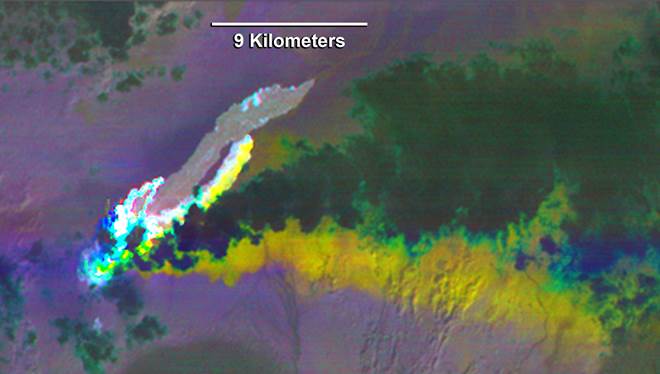Researchers from the University of Washington took advantage of the six-month-long Bárdarbunga-Veidivötn fissure eruption in Iceland, from August 31, 2014 to February 28, 2015, to investigate the effect of its sulfur dioxide (SO2) emissions on cloud albedo (reflectivity). During the eruption, it is estimated that the volcano emitted 12 million tons of SO2. See also: Albedo; Cloud; Volcano; Volcanology

Unlike violently explosive volcanoes, which may send SO2 high into the stratosphere, fissure volcanoes tend to release SO2 to the lower atmosphere (troposphere). In the troposphere, SO2 is converted to sulfuric acid (H2SO4), which condenses into small particles (aerosols). Water droplets tend to form (nucleate) around sulfuric-acid aerosols, so the effect of adding a lot of sulfuric acid to clouds is the formation of a greater number of smaller water droplets, which results in brighter, more reflective clouds. See also: Aerosol; Atmosphere; Atmospheric chemistry; Cloud physics; Sulfuric acid; Troposphere
For the months of September and October 2014, the researchers analyzed data collected from above Iceland by NASA’s orbiting Moderate Resolution Imaging Spectroradiometer (MODIS) instrument to measure the size of cloud water droplets. During the two-month period in which the data was analyzed, cloud droplets were the smallest seen in 14 years of MODIS data collected over Iceland, and solar radiation reflected by the clouds was measurably greater (Geophysical Research Letters, December 2015). See also: Meteorological satellites; Remote sensing
The significance of these findings is that volcanic emissions of SO2 in the lower atmosphere can potentially affect climate. Also, considering that about 75 percent of all SO2 emissions to the troposphere are anthropogenic, such as from combustion, anthropogenic sulfuric-acid aerosols may be offsetting some of the warming caused by rising concentrations of carbon dioxide and other greenhouse gases. See also: Aerosol-climate interactions; Geoengineering: enhancing cloud albedo; Global climate change





